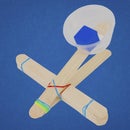Introduction: Articulated Grabber - Engineering Project for Kids
Have you ever dropped something behind the couch and couldn’t get it? Or perhaps your parents keep the best snacks on the top shelf, out of reach? If so, this project is perfect for you! This’ll extend your reach by over 30" (76cm)! I’ll show you how to make the basic grabber, and then it’s up to you to improve its grip. You can thank me later after you grab that package of cookies from the top of the fridge.
The grabber is just 1 of 18 hands-on projects from The STEAM Handbook! It's a book I wrote that's all about project-based learning for kids that blends applied Science, Technology, Engineering, Art, and Math. It's written in collaboration with Galileo Learning, whose mission is to develop the next generation of innovators who envision and create a better world. If you're into project-based learning, or just love making things with kids, then definitely grab a copy!
Step 1: Video Tutorial
To get started, just watch the video. For a materials list, step-by-step instructions, and inspiration for improving the grabber, keep going!
Step 2: Tools & Materials
For each grabber you'll need:
- clean and unbent cardboard
- ruler
- scissors
- sharpened pencil
- masking tape (Dispenser)
- 1.5" metal fasteners
- 1/8"x3.5" rubber band
- string
- craft sticks, foam, paperclips, or other materials for improving the grabber’s grip
- assorted objects to pick up
When you make a purchase through these links, I may earn an affiliate commission at zero cost to you.
Step 3: Create the Handle
Build the handle! Overlap the paint stirrers by about 4" (10cm), and wrap tightly with masking tape in at least 2 places.
Step 4: Cut the Cardboard
Cut the cardboard. Cut 10" (23cm) pieces of cardboard that are about 1.5" (3.8cm) wide. An adult may need to prep this step with a utility knife and cutting mat.
(Picture 1) If kids are doing this step, then you can make it easier to cut by scoring the cardboard with an open scissor blade first, then cut using scissors normally (Picture 2).
(Picture 3) Tip! For the strongest grabber possible, make sure to cut along the corrugations as shown.
(Picture 4) Each grabber needs three 10" (23cm) and two 5" (12.5cm) pieces.
Step 5: Poke Holes Into the Cardboard
(Picture 1) Use a sharpened pencil to poke hinge holes into the cardboard as shown.
(Picture 2) The holes should be at least ½" (1cm) from the edges, and they don’t need to be very big. Note that one piece isn’t poked at all. Keep your pencil sharp by placing a scrap piece of cardboard behind the area you’re piercing.
Step 6: Assemble the Grabber Mechanism
(Picture 1) Take the piece that doesn’t have holes, bend it in half, and tape it to the end of the handle as shown. Overlap most of it with the handle, but leave about 1" (2.5cm) of the folded side not overlapped with the wood. Poke a hole through that part of the cardboard.
(Picture 2) Assemble the cardboard as shown using a metal fastener. On the other side, fold the fastener tabs completely flat, and secure in place with a piece of tape.This step is important! If the fastener tabs are not folded and taped, the grabber will come undone!
(Picture 3) Attach the two 5" (12.5cm) pieces as shown. Remember to fold and tape the fastener tabs.
Step 7: Attach the Rubber Band and String
(Picture 1) Attach the rubber band! This will help automatically open up the grabber. Start by stretching the rubber band with both hands, and slipping it under the middle fastener as shown, then repeat with the other middle fastener. (Picture 2)
(Picture 3 & 4) Tie a piece of string to the fastener as shown. The grabber is ready to test! Give the string a tug, and your grabber should close.
Step 8: Improve the Grabber's Grip
Time to really start innovating! The basic grabber mechanism probably isn't working that well. It's up to you to use your available materials to figure out how to improve your grabber’s grip. Check out the pictures above for some inspiration.
For parents and teachers: Don’t hand out an unlimited amount of materials for improving the grabber. Assign a specific number of materials per child, such as 2 craft sticks, 1 small piece of cardboard, and 1 small rectangle of foam. Limiting the materials prompts children to use their available resources more creatively. Otherwise, they may try to solve their problems by simply adding on more and more materials, rather than thoughtfully testing and redesigning.
Step 9: Conquer Your Challenges!
Find 3-5 objects of different shapes, weights, and sizes. Try to pick them all up easily! You’ll probably find that your first grabber design doesn’t work perfectly. Be Determined! Don’t settle for a grabber that works just sometimes. Be willing to take apart your first idea and try something new until your grabber can pick up just about anything with ease!
Once you've conquered those challenges, look for other things to test your grabber's design. What about simple tasks, like pouring objects from one cup into another? Or can you grab a marker and write your name? Catch a ball mid-air? Keep finding new ways to push your design to the next level!






